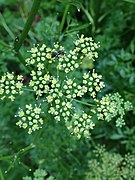Parsley
| Parsley | |
|---|---|

| |
| Parsley leaves and flowers | |
| Scientific classification | |
| Kingdom: | Plantae |
| Clade: | Tracheophytes |
| Clade: | Angiosperms |
| Clade: | Eudicots |
| Clade: | Asterids |
| Order: | Apiales |
| Family: | Apiaceae |
| Genus: | Petroselinum |
| Species: | P. crispum
|
| Binomial name | |
| Petroselinum crispum | |
| Synonyms[1] | |
|
List
| |
Parsley,orgarden parsley(Petroselinumcrispum) is a species offlowering plantin the familyApiaceaethat is native toGreece,Moroccoand the formerYugoslavia.[1]It has been introduced andnaturalizedin Europe and elsewhere in the world with suitable climates, and is widely cultivated as aherb,and avegetable.
It is believed to have been originally grown inSardiniaand was cultivated in around the 3rd century BC.Linnaeusstated its wild habitat to be Sardinia, whence it was brought to England and apparently first cultivated in Britain in 1548,[citation needed]though literary evidence suggests parsley was used in England in theMiddle Ages,as early as theAnglo-Saxon period.[2]
Parsley is widely used inEuropean,Middle Eastern,andAmerican cuisine.Curly-leaf parsleyis often used as agarnish.Incentral Europe,eastern Europe,and southern Europe, as well as inwestern Asia,many dishes are served with fresh green chopped parsley sprinkled on top.Flat-leaf parsleyis similar, but is often preferred by chefs because it has a stronger flavor.[3]Root parsleyis very common in central, eastern, and southern European cuisines, where it is used as a snack or a vegetable in many soups, stews, andcasseroles.
Etymology[edit]
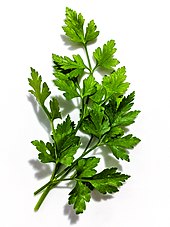
The word "parsley" is a merger ofOld Englishpetersilie(which is identical to the contemporaryGermanword for parsley:Petersilie) and theOld Frenchperesil.Both of these names are derived fromMedieval Latinpetrosilium,fromLatinpetroselinum,which is thelatinizationof theGreekπετροσέλινον,petroselinon,'rock-celery',[4][5]fromπέτρα,petra,'rock, stone'[6]andσέλινον,selinon,'celery'.[7][8][9]Mycenaean Greek se-ri-no, inLinear B,is the earliest attested form of the wordselinon.[10]
Description[edit]
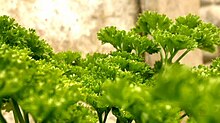
Garden parsley is a bright green,biennial plantin temperate climates, or anannualherb insubtropicalandtropicalareas.
Where it grows as a biennial, in the first year, it forms arosetteoftripinnateleaves 10–25 cm long with numerous 1–3 cm leaflets, and ataprootused as a food store over the winter. In the second year, it grows a flowering stem to 75 cm (30 in) tall with sparser leaves and flat-topped 3–10 cm diameterumbelswith numerous 2 mm diameter yellow to yellowish-green flowers.[9][11][12]
Theseedsareovoid,2–3 mm long, with prominentstyleremnants at theapex.One of the compounds of theessential oilisapiole.The plant normally dies after seed maturation.[9][11][12]
Uses[edit]
Culinary[edit]
This sectionneeds additional citations forverification.(February 2021) |
Parsley is widely used inMiddle Eastern,Mediterranean,Brazilian,andAmericancuisine. Curly leaf parsley is used often as agarnish.Green parsley is used frequently as a garnish on potato dishes (boiled or mashed potatoes), on rice dishes (risottoorpilaf), on fish, fried chicken, lamb, goose, andsteaks,as well as in meat or vegetable stews (including shrimp creole,beef bourguignon,goulash,orchicken paprikash).[13]
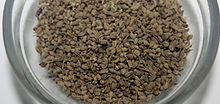
Parsley seeds are also used in cooking, imparting a stronger parsley flavor than leaves.[14][citation needed]
Parsley, when consumed, is accredited with neutralising odours associated with garlic in cooking.[15]
In central Europe, eastern Europe, and southern Europe, as well as in western Asia, many dishes are served with fresh green, chopped parsley sprinkled on top. In southern and central Europe, parsley is part ofbouquet garni,a bundle of fresh herbs used as an ingredient instocks,soups,andsauces.Freshly chopped green parsley is used as a topping for soups such aschicken soup,green salads, or salads such assalade Olivier,and onopen sandwicheswith cold cuts orpâtés.
Persilladeis a mixture of choppedgarlicand chopped parsley inFrench cuisine.
Parsley is the main ingredient in Italiansalsa verde,which is a mixed condiment of parsley, capers, anchovies, garlic, and sometimes bread, soaked in vinegar. It is an Italian custom to serve it withbollito mistoor fish.Gremolata,a mixture of parsley, garlic, and lemon zest, is a traditional accompaniment to the Italian veal stew,ossobuco alla milanese.
In England,parsley sauceis aroux-based sauce, commonly served over fish orgammon.It is also served withpie and mashin theEast End of London,and in fact all over London and The Home Counties, where it is referred to as Liquor.[original research?]
Root parsley is very common inCentral,Eastern,andSouthern Europeancuisines, where it is used as a snack or a vegetable in many soups, stews, andcasseroles,and as ingredient forbroth.
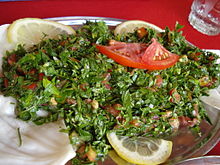
InBrazil,freshly chopped parsley (salsa) and freshly choppedscallion(cebolinha) are the main ingredients in the herb seasoning calledcheiro-verde(literally "green aroma" ), which is used as key seasoning for majorBrazilian dishes,including meat, chicken, fish, rice, beans, stews, soups, vegetables, salads, condiments, sauces, andstocks.Cheiro-verdeis sold in food markets as a bundle of both types of fresh herbs. In some Brazilian regions, chopped parsley may be replaced by choppedcoriander(also called cilantro,coentroin Portuguese) in the mixture.
Parsley is a key ingredient in several Middle Eastern salads such as Lebanesetabbouleh;it is also often mixed in with thechickpeasand/orfava beanswhile makingfalafel(that gives the inside of the falafel its green color). It is also a main component of theIranianstewghormeh sabzi.
Parsley is a component of a standardSeder platearrangement, it is eaten to symbolize the flourishing of the Jews after first arriving in Egypt.[16]
Composition[edit]
Nutritional content[edit]
| Nutritional value per 100 g (3.5 oz) | |
|---|---|
| Energy | 151 kJ (36 kcal) |
6.33 g | |
| Sugars | 0.85 g |
| Dietary fiber | 3.3 g |
0.79 g | |
2.97 g | |
| Vitamins | Quantity %DV† |
| Vitamin A equiv. | 47% 421 μg47% 5054 μg5561 μg |
| Thiamine (B1) | 7% 0.086 mg |
| Riboflavin (B2) | 7% 0.09 mg |
| Niacin (B3) | 8% 1.313 mg |
| Pantothenic acid (B5) | 8% 0.4 mg |
| Vitamin B6 | 5% 0.09 mg |
| Folate (B9) | 38% 152 μg |
| Vitamin C | 148% 133 mg |
| Vitamin E | 5% 0.75 mg |
| Vitamin K | 1367% 1640 μg |
| Minerals | Quantity %DV† |
| Calcium | 11% 138 mg |
| Iron | 34% 6.2 mg |
| Magnesium | 12% 50 mg |
| Manganese | 7% 0.16 mg |
| Phosphorus | 5% 58 mg |
| Potassium | 18% 554 mg |
| Sodium | 2% 56 mg |
| Zinc | 10% 1.07 mg |
| †Percentages estimated usingUS recommendationsfor adults,[17]except for potassium, which is estimated based on expert recommendation fromthe National Academies.[18] | |
Parsley is a source offlavonoidsandantioxidants,especiallyluteolin,apigenin,[19]folate,vitamin K,vitamin C,andvitamin A.Half a tablespoon (a gram) of dried parsley contains about 6.0μgoflycopeneand 10.7 μg ofAlpha caroteneas well as 82.9 μg oflutein+zeaxanthinand 80.7 μg ofbeta carotene.[20]Dried parsley can contain about 45mg/gramapigenin.[21]The apigenin content of fresh parsley is reportedly 215.5 mg/100 grams, which is much higher than the next highest food source, green celery hearts providing 19.1 mg/100 grams.[22]Parsley essential oil is high inmyristicin.[23]
Precautions[edit]
Excessive consumption of parsley should be avoided by pregnant women. Normal food quantities are safe for pregnant women, but consuming excessively large amounts may haveuterotoniceffects.[24]
Cultivation[edit]
Parsley grows best in moist, well-drained soil, with full sun. It grows best between 22–30 °C (72–86 °F), and usually is grown from seed.[12]Germination is slow, taking four to six weeks,[12]and it often is difficult because offuranocoumarinsin itsseed coat.[25]Typically, plants grown for the leaf crop are spaced 10 cm apart, while those grown as a root crop are spaced 20 cm apart to allow for the root development.[12]
Parsley attracts several species of wildlife. Someswallowtail butterfliesuse parsley as a host plant for their larvae;[26]their caterpillars are black and green striped with yellow dots, and will feed on parsley for two weeks before turning into butterflies. Bees and other nectar-feeding insects also visit the flowers.
Cultivars[edit]
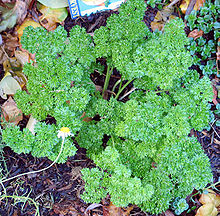
In cultivation, parsley is subdivided into severalcultivar groups,[27]depending on the form of the plant, which is related to its end use. Often these are treated as botanicalvarieties,[28]but they are cultivated selections, not of natural botanical origin.[11]
Leaf parsley[edit]
The two main groups of parsley used as herbs areFrench,orcurly leaf(P. crispumCrispum Group; syn.P. crispumvar.crispum); and,Italian,orflat leaf(P. crispumNeapolitanum Group; syn.P. crispumvar.neapolitanum).[29]Flat-leaved parsley is preferred by some gardeners as it is easier to cultivate, being more tolerant of both rain and sunshine,[30]and is said to have a stronger flavor[12]—although this is disputed[30]—while curly leaf parsley is preferred by others because of its more decorative appearance ingarnishing.[30][31]A third type, sometimes grown in southern Italy, has thick leaf stems resemblingcelery.[30]
Root parsley[edit]

Another type of parsley is grown as aroot vegetable,theHamburg root parsley(P. crispumRadicosum Group, syn.P. crispumvar.tuberosum). This type of parsley produces much thickerrootsthan types cultivated for their leaves. Although seldom used inBritainand theUnited States,root parsley is common incentralandeastern European cuisine,where it is used insoupsandstews,or simply eaten raw, as a snack (similar tocarrots).[30]
Although root parsley looks similar to theparsnip,which is among its closest relatives in the family Apiaceae, its taste is quite different.[32]
Gallery[edit]
-
Freeze-driedparsley showing name in German, Spanish and Greek on the label
-
Flat-leaved parsley
-
Flat-leaved parsley flower
-
Immature seeds
-
Flat-leaved parsley flower-Flor de perejil
-
Bee pollinator on parsleyPetroselinum crispumflower
See also[edit]
- Apium virus Y
- List of culinary herbs and spices
- List of plants with edible leaves
- List of vegetables
- Oenanthe javanica
- Cryptotaenia japonica
References[edit]
- ^ab"Petroselinum crispum (Mill.) Fuss".Plants of the World Online.Royal Botanic Gardens, Kew.Retrieved1 March2023.
- ^"More on Parsley".Monk's Modern Medieval Cuisine.26 October 2020.Retrieved24 January2022.
- ^"Parsley: More Than a Garnish | Illinois Extension | UIUC".extension.illinois.edu.2019-05-08.Retrieved2024-01-25.
- ^Lewis, Charlton T.; Short, Charles (1879)."petrŏsĕlīnon (-īnum )".A Latin Dictionary.Perseus Digital Library.
- ^Liddell, Henry George; Scott, Robert (1940)."πετροσέλινον".A Greek-English Lexicon.Perseus Digital Library.
- ^Liddell, Henry George; Scott, Robert (1940)."πέτρα".A Greek-English Lexicon.Perseus Digital Library.
- ^Liddell, Henry George; Scott, Robert (1940)."σέλινον".A Greek-English Lexicon.Perseus Digital Library.
- ^The Euro+Med Plantbase Project:Petroselinum crispumArchived2012-03-09 at theWayback Machine
- ^abcInteractive Flora of NW Europe:[1]
- ^"Palaeolexicon".Palaeolexicon. Archived fromthe originalon 13 April 2016.Retrieved23 July2018.
- ^abcBlamey, M.; Grey-Wilson, C. (1989).Illustrated Flora of Britain and Northern Europe.Hodder & Stoughton.ISBN0-340-40170-2.
- ^abcdefHuxley, A., ed. (1992).New RHS Dictionary of Gardening.Vol. 3. Macmillan. p. 532.ISBN0-333-47494-5.
- ^Meyer, J. (1998).Authentic Hungarian Heirloom Recipes Cookbook(2nd ed.). Meyer & Assoc.ISBN0-9665062-0-0.
- ^"Parsley: More Than a Garnish".30 July 2016.
- ^"The Martha Stewart method: How to easily remove garlic smell".TOI.14 March 2024.Retrieved21 May2024.
- ^"The Seder Plate".My Jewish Learning.Retrieved2023-02-08.
- ^United States Food and Drug Administration(2024)."Daily Value on the Nutrition and Supplement Facts Labels".FDA.Archivedfrom the original on 2024-03-27.Retrieved2024-03-28.
- ^National Academies of Sciences, Engineering, and Medicine; Health and Medicine Division; Food and Nutrition Board; Committee to Review the Dietary Reference Intakes for Sodium and Potassium (2019). Oria, Maria; Harrison, Meghan; Stallings, Virginia A. (eds.).Dietary Reference Intakes for Sodium and Potassium.The National Academies Collection: Reports funded by National Institutes of Health. Washington, DC: National Academies Press (US).ISBN978-0-309-48834-1.PMID30844154.Archivedfrom the original on 2024-05-09.Retrieved2024-06-21.
- ^Meyer, H.; Bolarinwa, A.; Wolfram, G. & Linseisen, J. (2006)."Bioavailability of apigenin from apiin-rich parsley in humans"(PDF).Annals of Nutrition and Metabolism.50(3): 167–172.doi:10.1159/000090736.PMID16407641.S2CID8223136.
- ^"Spices, parsley, dried Nutrition Facts & Calories".nutritiondata.self.Retrieved2023-02-08.
- ^Shankar E, Goel A, Gupta K, Gupta S (2017)."Plant flavone apigenin: An emerging anticancer agent".Current Pharmacology Reports.3(6): 423–446.doi:10.1007/s40495-017-0113-2.PMC5791748.PMID29399439.
- ^Delage, PhD, Barbara (November 2015)."Flavonoids".Linus Pauling Institute,Oregon State University,Corvallis, Oregon.Retrieved2021-01-26.
- ^Marín I, Sayas-Barberá E, Viuda-Martos M, Navarro C, Sendra E. Chemical Composition, Antioxidant and Antimicrobial Activity of Essential Oils from Organic Fennel, Parsley, and Lavender from Spain. Foods. 2016;5(1):18. Published 2016 Mar 4. doi:10.3390/foods5010018
- ^"Parsley Uses, Benefits & Side Effects - Drugs Herbal Database".Drugs.
- ^Jett, J. W.That Devilish ParsleyArchived2007-06-26 at theWayback MachineWest Virginia University Extension Service. Last retrieved April 26, 2007.
- ^Jackman, John A.; Drees, Bastiaan M. (1998-03-01).A Field Guide to Common Texas Insects.Taylor Trade Publishing.ISBN978-1-4616-2291-8.
- ^"M.M.P.N.D. - Sorting Petroselinum names".plantnames.unimelb.edu.au.Retrieved2023-02-08.
- ^"Petroselinum crispum".Germplasm Resources Information Network.Agricultural Research Service,United States Department of Agriculture.Retrieved10 December2017.
- ^Ciju, Roby Jose (2021-03-18).Leaves as Vegetables: Food Significance and Nutritional Information.AgriHortico.
- ^abcdeStobart, T. (1980).The Cook's Encyclopaedia.MacmillanISBN0-333-33036-6.
- ^"How To Grow Parsley".Herb Growing Guide.20 September 2020.Retrieved21 September2020.
- ^Davidson, Alan (2014-08-21).The Oxford Companion to Food.OUP Oxford.ISBN978-0-19-104072-6.
- Chisholm, Hugh,ed. (1911)..Encyclopædia Britannica(11th ed.). Cambridge University Press.
External links[edit]
 Media related toPetroselinum crispumat Wikimedia Commons
Media related toPetroselinum crispumat Wikimedia Commons Data related toPetroselinum crispumat Wikispecies
Data related toPetroselinum crispumat Wikispecies






